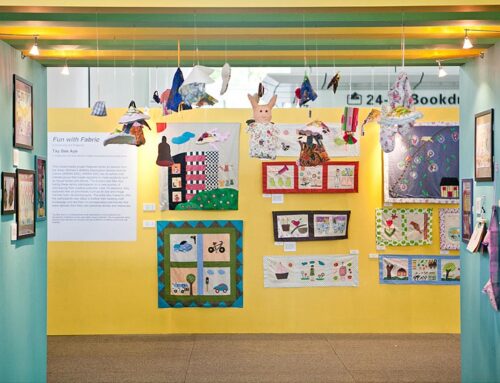Library / Field Studies
The Serious Pursuit of Play with anGie seah and Han Xuemei
Library / Field Studies
The Serious Pursuit of Play with anGie seah and Han Xuemei
Play is “pointless but significant”.1 It cannot be anything else. In this article, I grapple with the paradoxical convergence of “work” and “play”. Art and play are often inseparable. For some artists, the labour of making art is a serious yet enjoyable work of making the fun and strange. In this article, I look at the practices of Han Xuemei and anGie seah for insights into their seriously playful business of making work. In particular, I will seek to understand how the worlds of “play” and “work” converge for them and their participants in their latest works, Xuemei’s Flowers (2019) and anGie’s workshop process towards an installation and demo session titled Life mOvements (活动), and why these works matter.
Xuemei and anGie have been in the business of making community-based arts events in Singapore for many years. Xuemei has been working with Drama Box, a bi-lingual theatre company known for its community-based arts projects, for close to 10 years, while anGie documents her first community-based project as occurring in 2008. As research for this article, I interviewed the artists before immersing in their works as participant or observer. I participated in Xuemei’s Flowers, a participatory theatre experience that, along with her Missing (2018), departs from the community-based theatre framework; and I observed anGie at work with elderly residents in Telok Blangah under Drama Box and ArtsWok Collaborative’s ongoing Both Sides, Now, a community-based arts project. anGie named her John Cage-inspired music-making workshop series Life mOvements, or 活动 in Mandarin.
I found their works to be events in which play 2 is given space and time to take place. I found both to be interactive, social experiences that call on participants to freely remove themselves from their normal routines, arrive at a pre-agreed space and time to engage in activities that are beyond ordinary — absurd, even, to borrow anGie’s description. Both artists set parameters around which participants can safely set off, focus their energy and will to create and make their experience. At the height of their participation, I have observed participants lose themselves and “get seized” by a flow, when according to Tim Ingold (2010), thinking occurs through the doing,3 and everything else outside of play time and space is rendered momentarily hazy and meaningless.
The Exercise of Agency in Play
Why do people join Xuemei and anGie to make play? A part of the reason may concern the question of agency. Like John Cage and other Fluxus4 artists, anGie and Xuemei are in their own ways exploring granting agency in art-making to nature, people and objects. Both artists are occupied with the structuring of constructs in which participants can safely and freely explore consequences to exercising their agency. In their own ways, both are therefore concerned with granting participants space to — without consciously knowing — exercise attitudes, values and skills associated with civic participation.5 Participants could potentially make their own narratives, find enchantment, encounter beauty and joy, and become active agents to their own flourishing.6
“In the earlier years of my full-time practice, I spent quite a lot of time trying to define the art that I make and where I stand. Trying to find that voice, that colour… I don’t know if I am there yet, it is still a process of searching. Except now, the searching has become more pleasant; in a way, throughout the years, I have also adjusted myself and my perception of art-making, in that it will never be finished anyway. So there is no pressure. Searching for something actually frees me up more to play a bit with what I can do… I think in my earlier years I was much more burdened by these kinds of preconceived notions than I should be.”
– Han Xuemei
In an interview with Popspoken, Xuemei credited “Workshopping an Automatic Workshop” (Hong Kong, 2015), for introducing her to Fluxus and inspiring her to “explore the boundaries of audience participation”.7 Through Flowers, Xuemei appears to be working on allowing the chaos of different forms of participation to arise in a play-space of her design. In working on this design, Xuemei is particularly interested in harnessing the ‘life’ quality that objects could have as artefacts of lived history. When interviewing her for this article, she tells me about life that objects and spaces could have as “remnants… residues that existed before”. In Flowers, objects as lived artefacts are placed within the architecture of a space that is made to look like the interior of a house, seemingly lived in by an elderly man (played by an actor). These together form a coherent “vessel” for participants to potentially interact with, in a process of active meaning or narrative-making.8 Participants are invited to interact by moving in the construct as prying, meaning-making outsiders, as if they were ghost detectives.
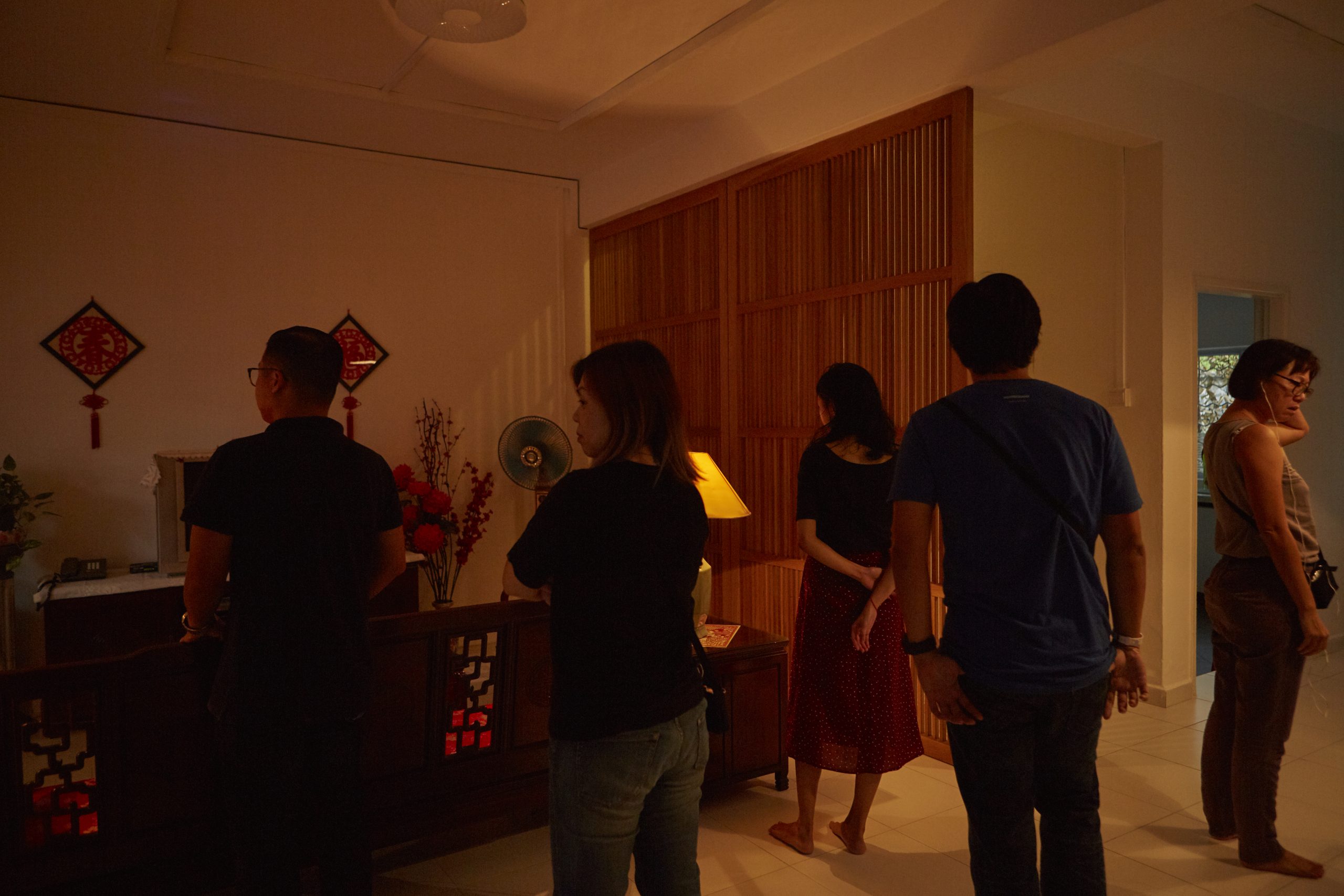
Once through the front door, participants of Flowers confront the construct, an ostensibly lived-in space, perhaps in a momentary state of disorientation. Image courtesy of Drama Box.
This freedom is intriguing when one considers the possibility of a participant simply arriving, entering the space, then walking out. Xuemei is open and accepting of such a scenario. It appears, from our exchange, that this is a process of her learning to let go of an attachment to heavy-handed executive structuring of audience experience:
“If you can tell from the way I put things, I have one part of me that is quite neat and tidy. And, in a way structured. Structure has been my greatest strength and also adversary. My mentors, Hui Ling, Heng Leun, have been telling me to lose that structure a bit, since the beginning. So that is something that has been the anchor of my artistic journey.”
As much as it is a manifestation of Xuemei’s effort to let go, Flowers is also an invitation to participants to let go of certain attachments in order to engage in a rather extraordinary way. A participant might find Flowers challenging if they were attached to conventional narrative experiences in theatre that are structured such that the audience, as a collective unit, is taken through a uniform experience. Flowers isn’t a theatre show. Xuemei’s invitation is for a vital facet of human agency — a playful, curious self which thirsts after meaning-making and expression — to be activated so that the participant moves and is moved in an active process of making.9 If a person shows up then leaves without interacting, then play hasn’t occurred for him/her.
“Xuemei’s invitation is for a vital facet of human agency — a playful, curious self which thirsts after meaning-making and expression — to be activated so that the participant moves and is moved in an active process of making. If a person shows up then leaves without interacting, then play hasn’t occurred for him/her.”
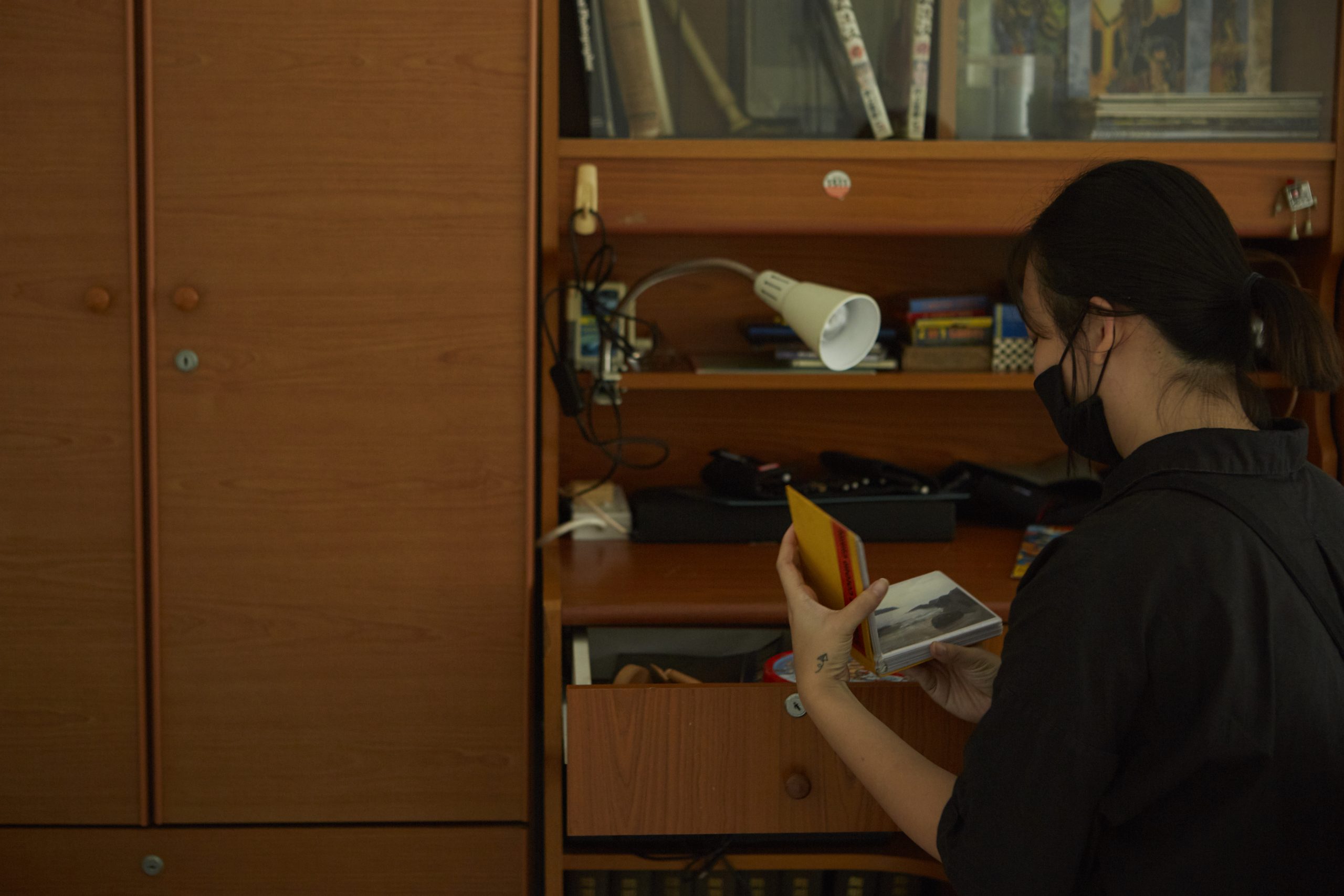
A participant of Flowers working to make meaning like a ghost detective. Image courtesy of Drama Box.
Play in Flowers depends on participants being active, willing to work, exercise and extend agency beyond self: commit to the imaginary construct, live within it and flow with it. What Xuemei is practicing and inviting us to practice when engaging in Flowers is to be a maker: to firstly accept strangeness and uncertainty, before finding our capacities for trust and faith. These ease us into activating our curiosity, imaginative and empathetic powers to navigate and negotiate through the uncertainty, and make meaning. As one instigates the unfolding of meaning, one finds a sense of achievement, then moves again amidst or against uncertainty of not knowing how things would continue to unfold. This process, very much inherent to the play process, is a rehearsal engaging the qualities that would guide one towards making choices that would lead to flourishing when navigating the uncertainty of life. It is very much work.
Exercise as an Art (of Living)
The oneness and porousness of life and art is a hallmark of Fluxus and anGie seah. anGie thrives on Fluxus’ call to be, live and practice art with the radical acceptance of the agency of uncertain elements of life. In our interview conducted for this piece, anGie explained her anthropological approach to art that informs her community projects.10 Guided by her curiosity to learn about the human condition, she approaches communities with the premise of making art together. It is by “doing”, interacting with her chosen social group in the process of collectively making art that she learns about them as fellow human beings. In that sense, life and its inherent uncertainties is anGie’s maker laboratory. Thus, a large part to anGie’s living and working philosophy is to remain porous to life in the Present (to borrow her phrasing), to feel and interact with nature, life and medium without falling into a deterministic mindset. anGie’s community art-making projects are therefore also guided by a will to uplift the human spirit.
“Art-making is, for me, a way to learn. To break boundaries. And create new possibilities. Whatever discipline I have worked with is actually a new possibility for me. I have never felt that I cannot do anything. Or that I cannot tap on any medium… I don’t have fear of knowing. I am a very curious person. So I will go and do it and find out. That is why even within communities I am able to get in touch and work with so many different participants with different backgrounds…
This relates to the element of play in my work: Why do I feel that I need to play? Not just because I feel it should be interactive. But at the same time, I am very serious about playing. I am very serious about the need to engage, to improvise, to experiment. And I feel this laboratory way of working is very important in my practice.”
– anGie seah
Life mOvements (活动), her weekly workshop with elderlies at Telok Blangah as part of Both Sides, Now, is ostensibly to her participants an experience in physical exercise first, experiential art or music-making second. This is very much in line with anGie’s intention. Her mandarin title of the project, 活动, is expanded to a call to action and health which she makes her participants repeat as a mantra: 活着要动 (in (healthy) living, one must move). She starts off the workshop with about ten minutes of tension-releasing stretches. anGie then proceeds to hand out props that they will use to make music for the day.11 She then goes on to teach them a number of gestures/movements and the matching symbol for each. She has a sequence of symbols drawn out on a white board, then she orchestrates: so as she points, from symbol to symbol, her participants will play the corresponding action. Her actions involve movement while remaining seated. It is through the movements (claps, etc.) and sometimes vocal projection accompanied by action and repeated sequences of these that everyone makes music.12 The process demands physical and vocal action.
anGie’s workshops may not demand that participants be makers since she devises the movements and does most of the orchestrating – she hands the job of orchestrating to volunteers when the participants are proficient enough. But participants are doing the work of making the music. Their work is to familiarise themselves with their everyday instruments, make music through doing without thinking: marshalling trust, good humour, and suspending disbelief in the process of working with the material objects they were given. This is only possible if participants can be in the present moment and suspend their thoughts regarding the end-goal. anGie recognises the humour and absurdity behind making elderlies swipe canes in the HDB void deck, and appreciates the trust, the joy and commitment with which the elderlies go about the practice:
“They just concentrate on the idea of doing… And they have fun when they are making sounds. They won’t think of what they do as absurd. So I find it to be a very good release mechanism. I feel it is very important for them to be rather more carefree and not so tense.”
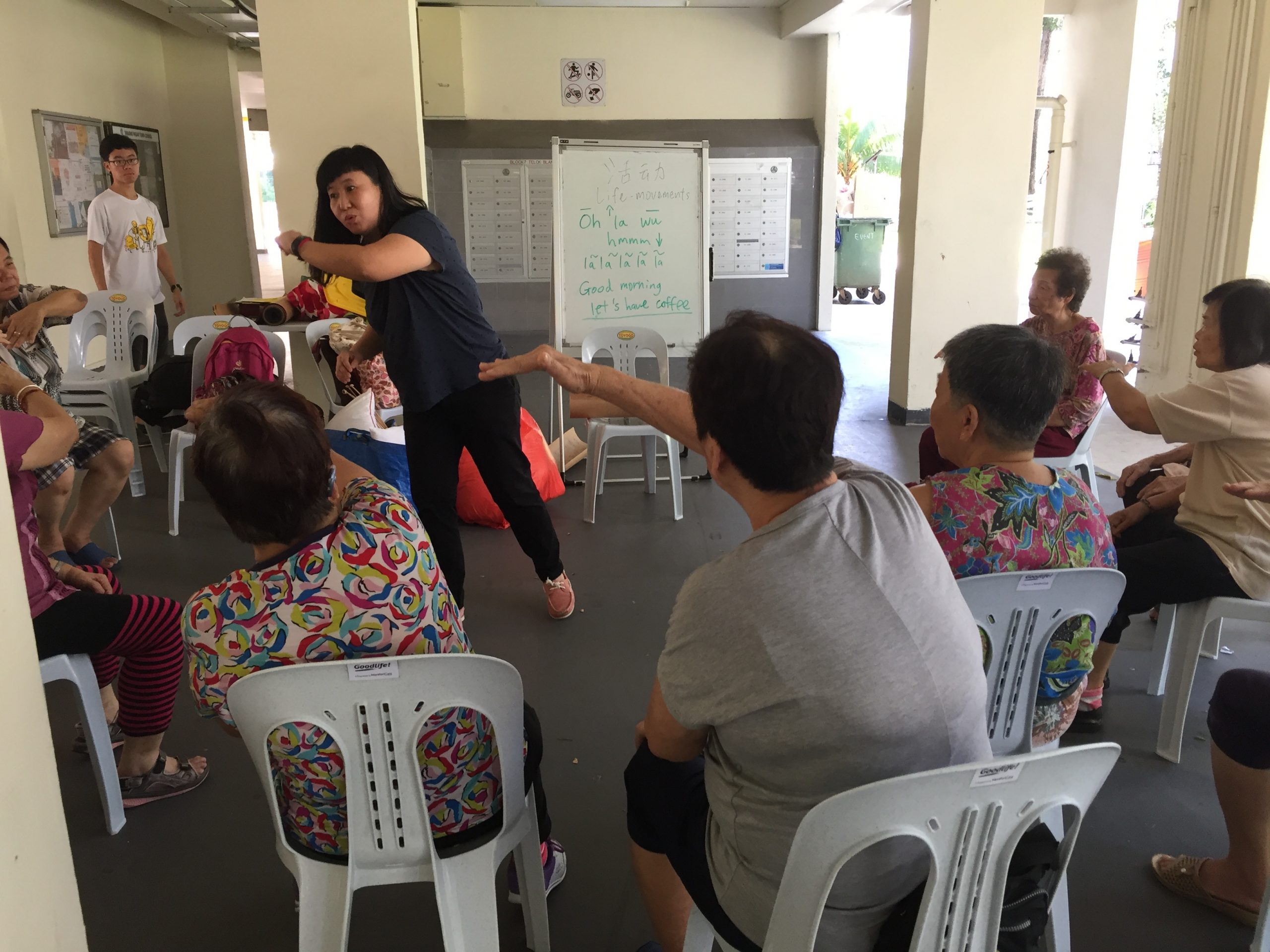
anGie Seah warming up by choreographing a sound-action accompanied by a similarly undulating voicing of the “u” sound. Image courtesy of Wong Yunjie.
“anGie is slowly proposing to participants an intriguing possibility through practice: they hold the potential to reconfigure their mundane Everyday so that it is latent with possibilities for wonder, beauty and joy.”
When they achieve the skill of playing with the alertness and finesse that anGie demands, and they are proficient at all their sound-actions, then they are ready to create a different practice flow. When that happens, they can recognise that they have come to make music — beauty — with everyday objects, their bodies and voices. If they would allow themselves to flow with the music they make, they would by extension allow themselves to recognise the possibilities for beauty that they and their instruments can create. anGie is slowly proposing to participants an intriguing possibility through practice: they hold the potential to reconfigure their mundane Everyday so that it is latent with possibilities for wonder, beauty and joy.
Conclusion
I return to the opening of this article: play is “pointless but significant”.13 It cannot be anything else: pointless, because it precedes obvious utility or functional outcome; significant, because it is necessary labour. anGie and Xuemei place participants in seemingly challenging situations and demand participants to engage with their work as makers. This role demands that participants invest in the work with serious commitment: commitment to the presented construct and its truths, commitment to the Present-in-flow and to move with it, commitment to allow meaning to unfold in its terms when it unfolds, and for Flowers in particular, commitment to persist at probing, prying and seeking meaning in uncertainty. By doing so, Xuemei and anGie are proposing to us the practice of thinking-through-doing as an art of living. They demand a relinquishing of the belief that we could hold control over the materials and nature. Yet through this relinquishing, we also find an elevation of a different agency — an activation of our innate, natural curiosity, love for truth, meaning and beauty.
This form of agency may have a place: to keep us moving and navigating through life’s vicissitudes satisfactorily. Once we can accept the truth of constant change, with some attitudinal shifts we can better allow meaning, beauty and goodness to unfold within ourselves and others. The world, Everyday life, the uncertainty of life: these can all be our laboratory if we allow ourselves to be open and present to its myriad possibilities. If we allow ourselves this space of flourishing, and want to share it with others, then we might be better placed for active world-making and its correlated real-world actions: nation-building, the work of civic participation and active citizenry.
[1] Huizinga, Johan. (1955). Homo Ludens: A Study of the Play Element in Culture, Beacon Press: Boston.
[2] Ibid.
[3] Ingold, Tim. (2010).The Textility of Making. Cambridge Journal of Economics, 34, 91-102.
[4] Fluxus is an international avant-garde collective of artists and composers formed in the 1960s that is not categorised by a particular style, but a mindset of fluidity. According to founder Maciunas, the purpose of Fluxus was to ‘promote a revolutionary flood and tide in art, promote living art, anti-art’. “Fluxus had no single unifying style. Artists used a range of media and processes adopting a ‘do-it-yourself’ attitude to creative activity, often staging random performances and using whatever materials were at hand to make art. Seeing themselves as an alternative to academic art and music, Fluxus was a democratic form of creativity open to anyone.” For more information, read Fluxus. Accessed 12 June 2019, https://www.tate.org.uk/art/art-terms/f/fluxus.
[5] Plato. (1994). Laws (Book VII). Accessed 20 April 2019 from http://classics.mit.edu/Plato/laws.7.vii.html.
[6] Dewey, John. (1922, reprinted 2012). Human Nature and Conduct: An Introduction to Social Psychology, London: Digireads.com.
[7] Flowers: An Interview with Han Xuemei. Accessed 30 April 2019, http://popspoken.com/arts/2019/04/flowers-an-interview-with-han-xuemei.
[8] Individual participants enter into this meaning-construct, armed with a taped recorder with the narrative, and for one hour are free to pry, listen to the recording, interact with the construct at any time to actively make meaning. In this set-up, a participant could simply arrive, enter the space, then walk out. Because of the individual nature of the participation, Flowers would continue unabated: the construct would run as choreographed while other participants continue their work of meaning-making. Xuemei planned and choreographed the actor’s performance so there are a number of “waystations” where the actor explicitly does something in the house. Participants can follow and observe him throughout. One can choose other points of engagement, such as independently enter into this space or that space and look into all the receptacles.
[9] Ingold. (2010). The Textility of Making, 91-102.
[10] anGie seah. Art with Communities. Accessed 25 April 2019, https://angieseah.com/art-with-communities/.
[11] When I attended as observer, she handed out a cane and a cushion to each participant.
[12] Most of the actions involved torso movement with sound, but later in the session which I sat in to observe, she also inserted a more challenging left-ward seated pelvic shift with a vocal projection (“OOOOHHH?”). A particular gesture, perhaps most indicative of anGie’s intentions at this workshop, is unique for being without sound: she makes them smile after producing laughter (Hahaha!).
[13] Huizinga, Johan. (1955). Homo Ludens: A Study of the Play Element in Culture, Beacon Press: Boston.
About Han Xuemei

HAN XUEMEI is a Singaporean arts practitioner who is curious about the possibilities of participation in artistic processes. She is keen on creating conditions and frameworks within which people exercise agency and make choices that deliberately intervene in their lives and disrupt their routines. Currently a resident artist with Drama Box, her recent explorations FLOWERS (2019), The Gift (2018) and MISSING: The City of Lost Things (2018) are multi-disciplinary experiences that engage the audience in deeply visceral and personal ways. Specifically, MISSING is a 4-hour introspective experience that invites the audience to participate in a journey to re-encounter lost connections. She has also co-created a few of the company’s socially-engaged projects, such as IgnorLAND of its Time (2014), SCENES: Forum Theatre (2015) and IgnorLAND of its Loss (2016). She has directed and facilitated some of the company’s theatre for young people, including forum theatre plays 40 Strokes (2013), sixpointnine (2015), as well as adaptations of Kuo Pao Kun’s plays – Silly Little Girl and Funny Old Tree (2014) and Kopitiam (2016).
About anGie seah
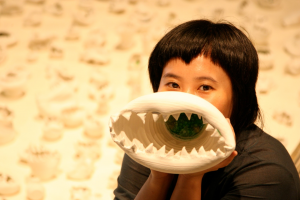
Born in 1979, anGie seah is a Singaporean artist. Her multidisciplinary practice traverses the mediums of drawing, sculpture, performance art, sound and video to respond to the enigma of life and explore facets of the human condition. Since 1997 anGie has exhibited works, taken part in artist residencies and participated in art festivals in locations such as Belgium (Les Halles de Schaerbeek), Germany (Goethe institute Berlin, ZKM Centre for new media), Japan (NIPAF/Fukuoka Asian Art Museum), Poland (Galeria labirynt, Interacjke festival), France (Palais de Tokyo, Museum of Contemporary arts Lyon, CITE des arts), Singapore (Singapore Biennale). For more than a decade, she has been actively involved in many community art projects locally and internationally, conducting participatory workshops for families, underprivileged children, youth-at-risk, children and seniors with special needs and the elderly. Working within a community is a way to attain a more complete understanding of the society one lives in. It provides an opportunity to step outside of her practice and be with the reality of life, through people.
About the writer
WONG YUNJIE (JACKY) is a theatre artist, researcher and writer concerned about the gaps to collective human flourishing in present-day capitalism. He is thus drawn to works, spaces and processes that help us interact with each other with openness and authenticity, and maintains a deep interest in Asian traditional art practices as embodied philosophy/values we are in danger of losing.
He is a graduate of the Intercultural Theatre Institute and National University of Singapore’s University Scholars Programme.





